Entries Tagged 'NONFICTION' ↓
August 21st, 2009 — Advertising, Art, Automotive, Design, DVD, NONFICTION, Pop Culture, Radio, Science-Fiction, Technology
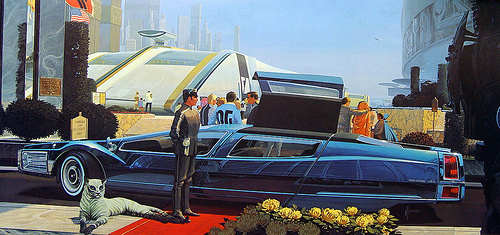


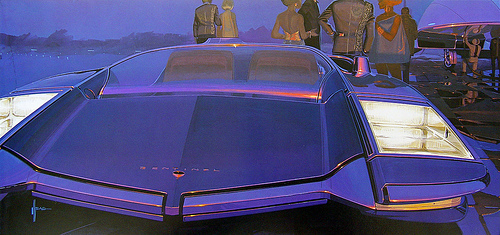

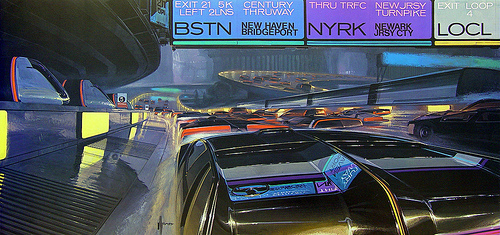
For years, conceptual designer Syd Mead has been the man to whom companies go when they need to advance an audacious vision of the impending future.
Sydney Jay Mead was born in 1933, in Saint Paul, MN, to a Baptist minister and his wife. After graduating from the Art Center in Los Angeles in 1959, he worked at Ford Motor Company’s Advanced Styling Center in Dearborn, MI for two years. He then spent part of the next decade rendering now legendary concept illustration for U.S. Steel, above. “He painted,” one Mead fan site notes, “using a slick, detailed method that made the future seem fresh, clean, and thrilling.” He started Syd Mead, Inc. in 1970.

 Soon, Hollywood came calling with movies that required his ultra-hard, visually authentic and tactile designs. (Mead lists his favorite metal as “chrome,” and his favorite color is, gulp, “Cherenkov radiation blue.”) His indelible technological notions were then emblazoned on sci-fi like Star Trek: The Motion Picture, Aliens, and Tron. (Indeed, some would argue that his US Steel snow walker, above right, obviously influenced another one in a galaxy far, far away, below right.)
Soon, Hollywood came calling with movies that required his ultra-hard, visually authentic and tactile designs. (Mead lists his favorite metal as “chrome,” and his favorite color is, gulp, “Cherenkov radiation blue.”) His indelible technological notions were then emblazoned on sci-fi like Star Trek: The Motion Picture, Aliens, and Tron. (Indeed, some would argue that his US Steel snow walker, above right, obviously influenced another one in a galaxy far, far away, below right.)

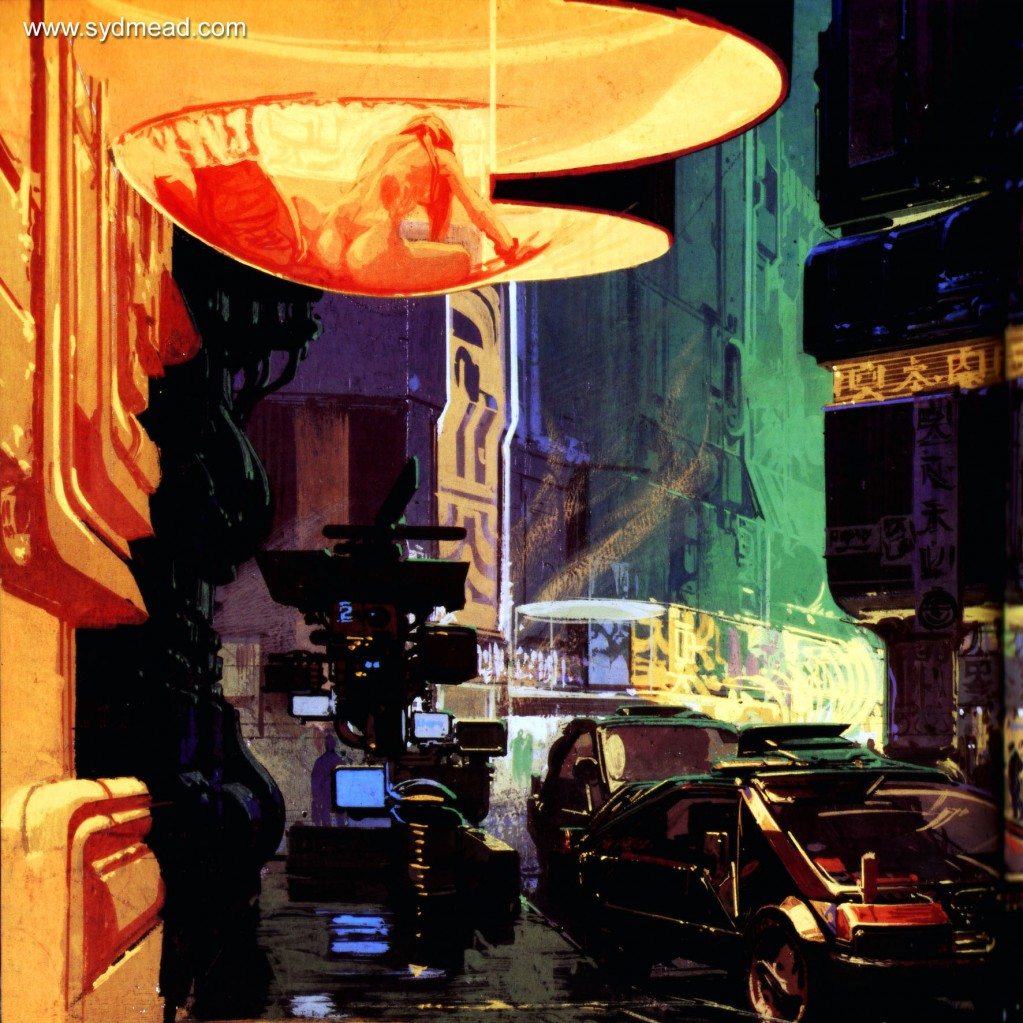
 But it was Blade Runner, right, Ridley Scott’s 1982 classic, on which Mead’s dystopic gigalopolis, both below right, most sears every frame. “In essence,” says author Paul Sammon (Future Noir: The Making of Blade Runner), “what you’re seeing in many shots are almost three-dimensional representations of Syd Mead’s art.”
But it was Blade Runner, right, Ridley Scott’s 1982 classic, on which Mead’s dystopic gigalopolis, both below right, most sears every frame. “In essence,” says author Paul Sammon (Future Noir: The Making of Blade Runner), “what you’re seeing in many shots are almost three-dimensional representations of Syd Mead’s art.”
Sammon, Mead, director Steven Lisberger (Tron) and other industry vets testify in director Joaquin Montalvan’s 2005 documentary, Visual Futurist: The Art & Life of Syd Mead. The film tells Mead’s story from his own perspective, as well as from that of the people with whom he’s worked. It’s a rich document about a little-known man, but one whose whose ideas are deeply and widely embedded in American popular culture.
Joaquin Montalvan is a guest today on my WBAI-NY / 99.5 FM radio show, NONFICTION, this afternoon, Friday, August 21, at 2 pm ET.
But first we’ll speak to Jason Del Gandio, author of Rhetoric for Radicals: A Handbook for 21st Century Activist, a guide for the ultra-political on how to effectively communicate. “Here’s the underlying logic” of his book, Del Gandio says:
• Change the rhetoric and you change the communication.
• Change the communication and you change the experience.
• Change the experience and you change a person’s orientation to the world.
• Change that orientation and you create conditions for profound social change.
You can hear Jason Del Gandio’s and Joaquin Montalvan’s ideas by tuning in at 2 pm. If you’re outside of the New York tri-state, check out our stream on the web. If you miss the live show, dig into our archives for up to 90 days after broadcast.
July 31st, 2009 — Art, Black Music, Books, Education, NONFICTION, Race

Yolande Cornelia “Nikki” Giovanni is not just one of the world’s greatest poets, with a legacy of profound and funky work, but a scholar with deep community interests and focuses. As a Distinguished Professor of English at Virginia Tech in Blacksburg VA since 1987, she trains future leaders in the literature of the mother tongue. As the author of over 30 books, she shares the beauty of poetic language with readers far and wide, having done so for over four decades. The above photo is drawn from the session for her first volume of work, Black Feeling, Black Talk, published in 1968, the year she turned twenty-five.
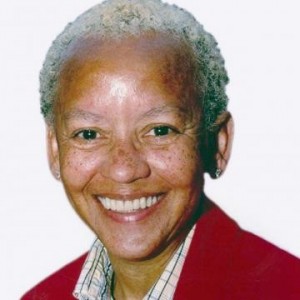 Unlike many poets, however, Giovanni, right, has long had an interest in reaching children. Her first book of verse for them, Spin a Soft Black Song, was published a mere three years after her first volume, in 1971, two short years after giving birth to her only child, Thomas Watson Giovanni.
Unlike many poets, however, Giovanni, right, has long had an interest in reaching children. Her first book of verse for them, Spin a Soft Black Song, was published a mere three years after her first volume, in 1971, two short years after giving birth to her only child, Thomas Watson Giovanni.
Her latest work, which she edited, continues her aim of making poetry come alive for young listeners and readers, albeit in a contemporary way. Hip-Hop Speaks to Children: A Celebration of Poetry with a Beat presents compositions by rap artists like A Tribe Called Quest, Queen Latifah, the Sugarhill Gang, and Stetsasonic along with classics by Claude McKay, Sterling Brown, Maya Angelou, and, of course, Nikki Giovanni. Children can read along in the profusely illustrated text while an accompanying CD presents most of the pieces in audio form, some of them read by the original poet. For me, the highlight had to be hearing Langston Hughes, performing his own poems, like “Dream Boogie” and “The Negro Speaks of Rivers.”
 Nikki Giovanni has had a long and varied career, appropriately honored with accolades from admirers as diverse as TV host Oprah Winfrey, whose hailed her as one of twenty-five “Living Legends”; to singer Teena Marie, who name-checked Giovanni on her 1981 hit, “Square Biz”; to biologist Robert Baker who, in 2004—no joke—named a West Ecuadoran bat he discovered, three years earlier, after her. Micronycteris giovanniae, which means meaning “Giovanni’s small night flyer,”looks much like the cuddly fellow above. “I enjoy reading her poetry and I come from the Deep South, so I really can appreciate what she has done for race relations and equality,” the professor explains.
Nikki Giovanni has had a long and varied career, appropriately honored with accolades from admirers as diverse as TV host Oprah Winfrey, whose hailed her as one of twenty-five “Living Legends”; to singer Teena Marie, who name-checked Giovanni on her 1981 hit, “Square Biz”; to biologist Robert Baker who, in 2004—no joke—named a West Ecuadoran bat he discovered, three years earlier, after her. Micronycteris giovanniae, which means meaning “Giovanni’s small night flyer,”looks much like the cuddly fellow above. “I enjoy reading her poetry and I come from the Deep South, so I really can appreciate what she has done for race relations and equality,” the professor explains.
Nikki Giovanni is the guest today on my WBAI-NY / 99.5 FM radio show, NONFICTION, this afternoon, Friday, July 31st, at 2 pm ET.
You can hear her ideas by tuning in at 2 pm. If you’re outside of the New York tri-state, check out our stream on the web. If you miss the live show, dig into our archives for up to 90 days after broadcast.
July 24th, 2009 — Education, NONFICTION, Race

Dr. Henry Louis “Skip” Gates, above, holds a unique, negative distinction in the history of NONFICTION, the hour-long radio show I’ve been doing every week at WBAI-NY / 99.5 FM since 2003: He was, when he appeared on the broadcast in January 2004, and still is, the tardiest guest to ever actually get on air, strolling in literally about five minutes before I opened my mic. (I typically ask guests to be an hour early for our live show.)
 Of course, these days, Dr. Gates has notoriety of a wholly different magnitude, as a result of being arrested, a little over a week ago, Thursday, July 16, 12:44 pm, by Sgt. James Crowley of the Cambridge MA police department, inside Dr. Gates own home. (By the Blackest of coincidences, it was the same day President Obama would address the NAACP, in celebration of their 100th anniversary.) After a passerby saw Gates trying to break into his own yellow, clapboard house—the front door was damaged and stuck—the woman called the police and, after a verbal confrontation in Gates’ home, he was led out of his own door, above, and off of his own porch, in handcuffs.
Of course, these days, Dr. Gates has notoriety of a wholly different magnitude, as a result of being arrested, a little over a week ago, Thursday, July 16, 12:44 pm, by Sgt. James Crowley of the Cambridge MA police department, inside Dr. Gates own home. (By the Blackest of coincidences, it was the same day President Obama would address the NAACP, in celebration of their 100th anniversary.) After a passerby saw Gates trying to break into his own yellow, clapboard house—the front door was damaged and stuck—the woman called the police and, after a verbal confrontation in Gates’ home, he was led out of his own door, above, and off of his own porch, in handcuffs.
Supposed the conflict had escalated, and Gates had been beaten, wounded, shot, or killed? How would this have then played out? Would it have been just another parade of somber white faces and furious, stunned Black ones? How would the story of what had happened have been told, and by whom?
I wonder how that Black cop, in the foreground, above, feels. Bet it’s not a party for him, either.
Did you know that Black cops are nine times more likely to be shot by a fellow white officer than a white cop is?
When Gates and I met to talk about his then latest book and documentary, America Behind The Color Line: Dialogues with African-Americans, those questions were certainly as far away from his mind as Cambridge is from China, that being the country from which he’d just returned that fateful day.
He was late to my interview. But better late than never.
Dr. Henry Louis Gates is the guest today on this repeat edition of my WBAI-NY / 99.5 FM radio show, NONFICTION, this afternoon, Friday, July 24th, at 2 pm ET.
You can hear his ideas by tuning in at 2 pm. If you’re outside of the New York tri-state, check out our stream on the web. If you miss the live show, dig into our archives for up to 90 days after broadcast.
July 17th, 2009 — NONFICTION, Technology

Software, arguably, rules the world. It’s the basis of computing in all forms, from your microwave oven to your cell phone to the internet. Yet, it is invisible, ethereal, hard to understand, and even harder to create well.
But software can be made expertly, with great results, when one puts together and manages a great team. But how does one do that?
In his new book, Growing Software: Proven Strategies for Managing Software Engineers, Louis Testa talks about how making great software is, really, a task of managing and choosing good people, a needed skill in any realm.
Louis Testa the guest today on my WBAI-NY / 99.5 FM radio show, NONFICTION, this afternoon, Friday, July 17th, at 2 pm ET.
You can hear his ideas by tuning in at 2 pm. If you’re outside of the New York tri-state, check out our stream on the web. If you miss the live show, dig into our archives for up to 90 days after broadcast.
July 10th, 2009 — Books, Internet, Language, NONFICTION

Would you believe anything he told you about the car you were buying from him, about your future with the company, or about you?
Probably not. But why? And, even more, when you speak, do people see you the same way? That is, do you, even unintentionally, convey that you are not to be liked or believed?
In his new book, Trust Me: Four Steps to Authenticity and Charisma, Nick Morgan, PhD., a top communication and speech coach, author, and blogger, delivers the critical knowledge on how “to be an effective speaker by presenting an image of authenticity and respect for [an] audience, whether in a group presentation or a one-on-one conversation.”
Undergirding his approach is
the fact that when words and body language are in conflict, body language wins every time. This isn’t easy to overcome, because normally body language is immediate, while the words lag slightly behind, and even a momentary conflict is perceptible to the audience. The key to success is to train your body language to unconsciously align with your message.
Nick Morgan is a guest today on my WBAI-NY / 99.5 FM radio show, NONFICTION, this afternoon, Friday, July 10, at 2 pm ET.
 Then, we’ll announce the three winners of O’Reilly Media founder Tim O’Reilly and Sarah Milstein’s new volume, The Twitter Book, right. Sarah was our guest last week on NONFICTION, and an amazing, informed—and generous!—guest.
Then, we’ll announce the three winners of O’Reilly Media founder Tim O’Reilly and Sarah Milstein’s new volume, The Twitter Book, right. Sarah was our guest last week on NONFICTION, and an amazing, informed—and generous!—guest.
Then, finally, our long-delayed conversation with Ellen Lupton, director of the Graphic Design MFA program at Maryland Institute College of Art (MICA) in Baltimore, and author of the new book, Indie Publishing: How to Design and Produce Your Own Book, a step-by-step guide to being your own publisher. “Once referred to derisively as ‘vanity publishing,'” she says, “self-published books are finally taking their place alongside more accepted indie categories such as music, film, and theater.”
You can hear Nick Morgan’s and Ellen Lupton’s ideas by tuning in at 2 pm. If you’re outside of the New York tri-state, check out our stream on the web. If you miss the live show, dig into our archives for up to 90 days after broadcast.
July 3rd, 2009 — Internet, Media, NONFICTION, Technology

The day Michael Jackson died, it was a message on the social messaging service, Twitter, above, from TMZ head Harvey Levin that started the massive cascade of fear, grief, reminiscence, and adoration that ultimately swept the globe. Levin’s tweet, as Twitter messages are called, was a mere 77 characters in length, just a bit more than half the service’s maximum, 140 characters-per-message capacity. Rarely does such a small amount of text have such an immense, and rapid, effect.
Yet, whether in the death of a celebrity, or an uprising in a Middle eastern country—Twitter has been central, in terms of getting news out of that land, after their disrupted elections—the technology is making itself felt. In her new volume, The Twitter Book, co-written with O’Reilly Media founder Tim O’Reilly, Sarah Milstein talks about what Twitter is, how to get on it, and how to make it work for you. It’s a convenient to carry, easily-read book, just right for the neophyte, but with enough substance for power-users. Indeed, as the 21st person on the network—her boyfriend was an engineer with the young company—and a well-know consultant and author, Milstein definitely knows her stuff…and her Twitter.
Sarah Miltein is the guest today on my WBAI-NY / 99.5 FM radio show, NONFICTION, this afternoon, Friday, July 3rd, at 2 pm ET.
You can hear her ideas by tuning in at 2 pm. If you’re outside of the New York tri-state, check out our stream on the web. If you miss the live show, dig into our archives for up to 90 days after broadcast.
June 26th, 2009 — Black Music, NONFICTION, Obituary
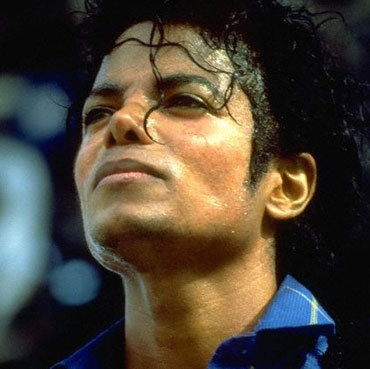
Today, on NONFICTION, I’ll be talking about the life and music of the late, great Michael Jackson, who died yesterday, with ethnomusicologist Dr. Kyra Gaunt and music writer Michael Gonzales, author of “Remembering The Times: Memories of Mike.”
You can hear their ideas by tuning in at 2 pm. If you’re outside of the New York tri-state, check out our stream on the web. If you miss the live show, dig into our archives for up to 90 days after broadcast.
June 19th, 2009 — Media, NONFICTION, Radio, Religion, Science
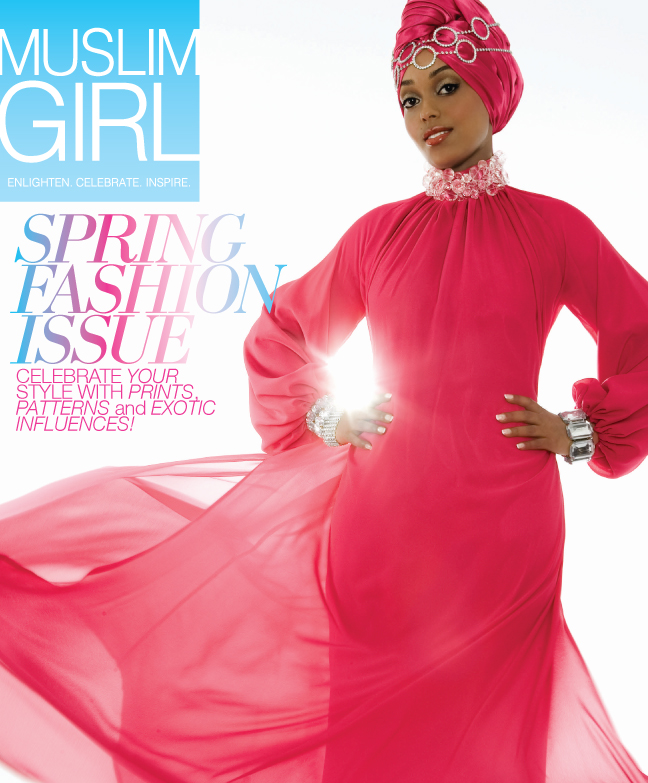
The over 400,000 women, ages 18-24, in the U.S. and Canada who practice Islam have been dutifully represented, bimonthly since 2007, by Muslim Girl magazine, the only beauty and lifestyle publication that targets young females of the faith.
Unfortunately, the mag has not published an issue since this one, above, in the spring of 2008. As Ausma Khan, editor-in-chief, noted in a letter to readers on the Girl‘s web site, the causes are “the current state of the economy and the overall decline in the print industry,” but, also, uniquely, “an advertising industry that is risk-averse to our name and audience.”
I’m personally hoping that Muslim Girl will revive and thrive. Though neither a Muslim nor a girl, I found it an exciting, thought-provoking, and colorful read. Normally, this is the part where most would also probably say something about hoping we can one day live in a country where all people are respected, no matter what their religion, skin color, etc. However, I’m Black.
Magazine or no magazine, Ausma Khan is a smart and analytical thinker on many issues, and especially on ones muslim girls face. That’s why she’s a guest today on this repeat edition of my WBAI-NY / 99.5 FM radio show, NONFICTION, this afternoon, Friday, June 19, 2 pm ET.
 As well, I’ll be speaking with astrophysicist Dr. Janna Levin, right. (You may recall me mentioning her, last week, in my post on whether or not the universe is conscious and alive.)
As well, I’ll be speaking with astrophysicist Dr. Janna Levin, right. (You may recall me mentioning her, last week, in my post on whether or not the universe is conscious and alive.)
She’s giving a lecture here in New York, next week, Tuesday, June 23, 2009, 8:00 PM, at Columbia University’s Lerner Hall, as part of the 8th Edoardo Amaldi Conference on Gravitational Waves. Janna’s talk, Songs from Space: Black Holes and the Big Bang in Audio, will show how physicists are using audio, animation, and other aids to make the wonders of the cosmos more real to regular people. (Check out her cool poster.) Plus, we’ll be playing one or two weird-sounding samples from her talk, in advance, during the broadcast!
You can hear Ausma Khan’s and Janna Levin’s ideas by tuning in at 2 pm. If you’re outside of the New York tri-state area, you can check out our stream on the web. If you miss the live show, fly over to our archives for up to 90 days after the broadcast.
June 12th, 2009 — Books, NONFICTION, Science

Everybody knows that the universe is big, and everybody knows that it was here long before there were people.
But is the universe alive?
By this, I don’t mean in the sense that, say, freedom can be alive, or the way an ocean can be alive because it’s filled with living things.
I mean, is the universe, itself, alive? To put it roughly, is the universe somewhat akin to a big animal?
Continue reading →
June 5th, 2009 — Art, Gender, NONFICTION, Photography

For his book Flight Attendants, documentary photographer Brian Finke spent two years flying the friendly skies, with airline carriers from all over the world, in order to record the work, leisure time, and home lives of his volume’s titular employees. For example, this woman, Roshayati, above, was giving a safety demo before her Air Asia flight’s departure.
 Rachel Papo‘s Serial No. 3817131 goes inside the days and nights of young women in Israel’s Defense Forces, for whom service is mandatory, as it is for all young people in the that country. (The book’s title was Papo’s own i.d. number during her military stint in the late ’80s.) As the body language and expression on the face of the soldier, above, makes clear, not only is war long stretches of boredom spiked my moments of sheer terror, preparing for it, apparently, is also.
Rachel Papo‘s Serial No. 3817131 goes inside the days and nights of young women in Israel’s Defense Forces, for whom service is mandatory, as it is for all young people in the that country. (The book’s title was Papo’s own i.d. number during her military stint in the late ’80s.) As the body language and expression on the face of the soldier, above, makes clear, not only is war long stretches of boredom spiked my moments of sheer terror, preparing for it, apparently, is also.
What’s truly interesting, though, is that while these women’s occupations seem to be as different as they get, they share more than might immediately be apparent. Safety, training, freedom, even boredom all weigh heavily as issues in their respective fields. That became clear to me, at least, when I had the chance to talk to Papo and Finke about their own work.
Both artists are guests today on my WBAI-NY / 99.5 FM radio show, NONFICTION, this afternoon, Friday, June 5, at 2 pm ET.
You can hear their ideas by tuning in at 2 pm. If you’re outside of the New York tri-state, check out our stream on the web. If you miss the live show, dig into our archives for up to 90 days after broadcast.







 Soon, Hollywood came calling with movies that required his ultra-hard, visually authentic and tactile designs. (Mead lists his favorite metal as “chrome,” and his favorite color is, gulp, “Cherenkov radiation blue.”) His indelible technological notions were then emblazoned on sci-fi like Star Trek: The Motion Picture, Aliens, and Tron. (Indeed, some would argue that his US Steel snow walker, above right, obviously influenced another one in a galaxy far, far away, below right.)
Soon, Hollywood came calling with movies that required his ultra-hard, visually authentic and tactile designs. (Mead lists his favorite metal as “chrome,” and his favorite color is, gulp, “Cherenkov radiation blue.”) His indelible technological notions were then emblazoned on sci-fi like Star Trek: The Motion Picture, Aliens, and Tron. (Indeed, some would argue that his US Steel snow walker, above right, obviously influenced another one in a galaxy far, far away, below right.)

 But it was Blade Runner, right, Ridley Scott’s 1982 classic, on which Mead’s dystopic gigalopolis, both below right, most sears every frame. “In essence,” says author Paul Sammon (Future Noir: The Making of Blade Runner), “what you’re seeing in many shots are almost three-dimensional representations of Syd Mead’s art.”
But it was Blade Runner, right, Ridley Scott’s 1982 classic, on which Mead’s dystopic gigalopolis, both below right, most sears every frame. “In essence,” says author Paul Sammon (Future Noir: The Making of Blade Runner), “what you’re seeing in many shots are almost three-dimensional representations of Syd Mead’s art.”

 Nikki Giovanni has had a long and varied career, appropriately honored with accolades from admirers as diverse as TV host Oprah Winfrey, whose hailed her as one of
Nikki Giovanni has had a long and varied career, appropriately honored with accolades from admirers as diverse as TV host Oprah Winfrey, whose hailed her as one of 
 Of course, these days, Dr. Gates has notoriety of a wholly different magnitude, as a result of being arrested, a little over a week ago, Thursday, July 16, 12:44 pm, by Sgt. James Crowley of the Cambridge MA police department, inside Dr. Gates own home. (By the Blackest of coincidences,
Of course, these days, Dr. Gates has notoriety of a wholly different magnitude, as a result of being arrested, a little over a week ago, Thursday, July 16, 12:44 pm, by Sgt. James Crowley of the Cambridge MA police department, inside Dr. Gates own home. (By the Blackest of coincidences, 





 As well, I’ll be speaking with
As well, I’ll be speaking with 


